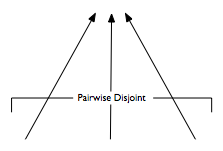Modelling various descriptive "features" (also known variously as
"qualities", "attributes" or "modifiers") is a frequent requirement
when creating ontologies. For example: "size" may describe persons or
other physical objects and be constrained to take the values "small",
"medium" or "large"; rank may describe military officers and restricted
to a specific list of values depending on the military
organisation. In OWL such descriptive features are modelled as
properties whose range specifies the constraints on the values that the
property can take on. This document describes two methods to
represent such features and their specified values: 1) as partitions of
classes; and 2) as enumerations of individuals. It does not
discuss the use of datatypes to represent lists of values.
Status of this Document
This section describes the status of this document at the time of its publication.
Other documents may supersede this document. A list of current W3C publications
and the latest revision of this technical report can be found in the W3C
technical reports index at http://www.w3.org/TR/.
This document is a Working
Group Note, produced by the Ontology
Engineering and Patterns Task Force in the Semantic
Web Best Practices and Deployment Working Group, part of the
W3C Semantic Web Activity.
This document is one of a series of documents that is produced by the
task force. Comments on this document may be sent to
public-swbp-wg@w3.org,
a mailing list with a
public archive.
Publication as a Working Group Note does not imply endorsement by the W3C
Membership. This is a draft document and may be updated, replaced or
obsoleted by other documents at any time. It is inappropriate to cite
this document as other than work in progress.
General issue
It is a common requirement in developing ontologies to be able to
represent notions such as a "small man", a "high ranking officer" or a
"health person." There are many such "features" (also known as
"qualities", "attributes", or "modifiers") . In almost all such
cases it is necessary to specify the constraints on the values for the
"feature" - e.g. that size may be "small", "medium" or "large" or that
a person may be in "poor health", "medium health" or "good
health". In some
circumstances
we may also want to represent modified values - e.g.
"very large", "moderately large", etc. or to otherwise further
subdivide the original values. In
other
circumstances it is useful to be able to have two different collections
of
values covering the same feature, for example to have different
collections
of color values all partitioning the same "colour space" or to break up
"health status" into four rather than three levels.
There are at least three different ways to represent such specified
collections of values:
- As individuals whose enumeration makes up the parent class
representing the feature; (See pattern 1).
- As disjoint classes which exhaustively partition the parent class
representing the feature. (see pattern 2);
- As datatypes. Data types will more usually be used when there is
a literal, numeric or derived data types rather than when there is an
enumerated list of values. (Datatypes will not be considered further in
this
note because technical discussions are still continuing in other W3c
committees. A supplement may be issued later when these issues
are resolved.)
Use case examples
We want to describe persons as having qualities such as having size
that is small, medium or large, body
type
that is slender, medium, or obese and as having health status that is
good
health, medium health, or poor health. It should not be possible to
have more
than one value for any of the qualities, e.g. it should be
inconsistent (unsatisfiable) to be both slender and obese or in good
health
and poor health. We will use the feature "Health" in the examples. The
others
follow analogously.
Conventions used in this note
Diagramming
The diagramming conventions used in this document are summarised
below. Examples are given in the appendix.
- Ellipses represent classes.
- Squares represent instances.
- Arrows:
- Closed
undecorated arrows (pointing upwards if possible) represent
rdfs:subclassOf;
- Open undecorated arrows indicate
rdf:type;
- arrows decorated with a blob on the origin
indicate
restrictions if between classes or facts if between individuals.
- Dotted arrows indicate that
the information represented is inferrable by a reasoner and not present
explicitly in the code given.
- Upward
facing square union symbols if spanning a set of
rdfs:subclassOf
arrowsor rdf:type arrowsindicate that the subclasses or individuals
exhaust the class - i.e. that they cover all possibilities. This
is expressed in OWL using owl:unionOf for classes or owl:oneOf for individuals
- Downwards facing braces
are used to indicate pairwise disjointness between subclasses or
owl:allDifferent for individuals. (All sibling
classes are disjoint and all individuals of each type are different in
these examples.)
Syntax for code
In keeping with SWBP policy, the syntax within the body of note is
N3. Details in alternative syntaxes are given by links.
Vocabulary
"Partition" - a class
is partitioned by a group of subclasses if a) the subclasses are
mutually exclusive, i.e. pairwise disjoint; and b) the subclasses
completely cover the parent class, i.e. that the union of the
subclasses is equal to the parent class.
"Feature" - a characteristic
of some entity. Other words for feature include "quality" [Welty
and Guarino], "attribute", "characteristic", and "modifier". For
purposes of this note no distinction will be made between these
terms. For further information on representing more complex
"qualities" see the note on N-ary Relations.)
"Feature space" - the range
of values that a feature can take on conceived of as a continuous range
or 'space'. Also called quality space, see [Welty and Guarino].
Representation patterns
Two patterns are introduced. The first is simple and intuitive
but has limitations. The second is more complex but is more
flexible. Some classifiers also work more reliably with Pattern 2
than Pattern 1.
Pattern 1: Values as sets of individuals
In this approach, the class Health_Value is considered
as the
enumeration of the individuals good_health,
medium_health, and poor_health. Values are
sets of
individuals. To say that "John is is in good health", is to say that
"John
has the value good_health for health_status"
This assumes that a value is just
a
unique symbol, and a value set is just a a set of such symbols.
Normally, the
values will all need to be asserted to be different from each other. In
OWL, any two individuals might represent the same thing unless there is
an
axiom to say, explicitly, that they are different. In other words, OWL
does
not make the "Unique Names Assumption". If we did not include the
differentFrom axiom in the example, then it would be
possible that good_health and poor_health
where the same thing, so that it would be possible to
have a person who was both in good health and poor health
simultaneously.
The approach is shown diagrammatically in Figure 1.
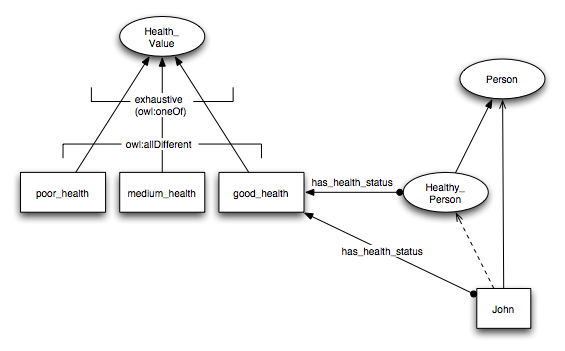
Figure 1: A class-instance diagram of the use of enumerated
instances to represent lists of values
Representation for Pattern 1
{{The value set and make it equal to
the enumeration of the three individual values}}
:Health_value
a owl:Class ;
owl:equivalentClass
[ a owl:Class ;
{{Define as one of three individuals}}
owl:oneOf (:medium_health :good_health :poor_health)
] .
:good_health
a :Health_value ;
{{The next line make values different. Otherwise might be inferred the same}}
owl:differentFrom :poor_health , :medium_health .
{{Define each of the individual values as an individual of type Health_value}}
:medium_health
a :Health_value ;
owl:differentFrom :poor_health , :good_health .
:poor_health
a :Health_value ;
owl:differentFrom :good_health , :medium_health .
:has_health_status
a owl:ObjectProperty , owl:FunctionalProperty ;
rdfs:range :Health_value .
{{Define the individual John - and state that he has health_status good_health}}
:John
a :Person ;
:has_health_status :good_health .
{{Define the class Healthy_Person as the class of Person that has health_status good_health}}
{{ i.e. an individual of type (Person AND has_health_status value(good_health))
:Healthy_person
a owl:Class ;
owl:equivalentClass
[ a owl:Class ;
owl:intersectionOf (:Person
[ a owl:Restriction ;
owl:hasValue :good_health ;
owl:onProperty :has_health_status
])
] .
Considerations using Pattern 1:
- There is a straight forward match to the usage in databases and
many frame systems without any assumptions or conventions about
anonymous individuals.
- Many people find this the more intuitive approach.
- There is no possibility of further subpartitioning of values.
This is because OWL supports only equality or difference between
individuals. It does not allow individuals to have partial overlaps. It
is not possible, as it is for classes, to say that one individual is
equivalent to the the union (disjunction) of two other individuals.
- There is no way to represent alternative partitionings of the
same feature space. Because individuals cannot overlap, if
Health_Value
is defined as equivalent to enumeration of one list of distinct values,
it cannot also be equivalent to a different list of distinct values. To
do so would cause the reasoner to indicate a contradiction. (i.e that Health_Value
was "unsatisfiable".)
- The representation is in OWL-DL, and DL reasoners should
eventually be expected to make correct inferences with individuals used
in this way. However, neither FaCT nor Racer (the two most widespread
open source reasoners in use today) perform all the expected inferences
reliably.
OWL code for this example
[N3] [RDF/XML abbrev] [Abstract syntax]
Pattern 2: Values as subclasses partitioning
a
"feature"
In this approach we consider the feature as a class representing a
continuous space that is partitioned by the values in the collection of
values. To say that "John is in good health" is to say that his health
is
inside the Good_health_values partition of the
Health_value feature. Theoretically, there is an
individual
health value, Johns_health, but all we know about it is
that it
lies someplace in the Good_health_value partition. The
cass
Healthy_Person is the class of all those persons who have
a
health in the Good_health_value partition.
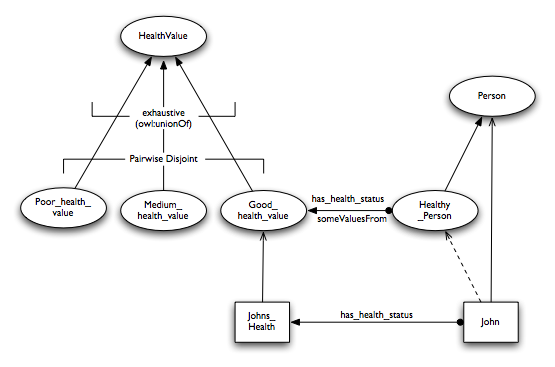
Figure 2: A class-instance diagram of the use of
partitioning
classes for collections of values
Some may find an alternative diagrammatic format adapted from Venn
diagrams as shown in Figure 3 makes the intention clearer as it shows
the
partioning more explicitly.
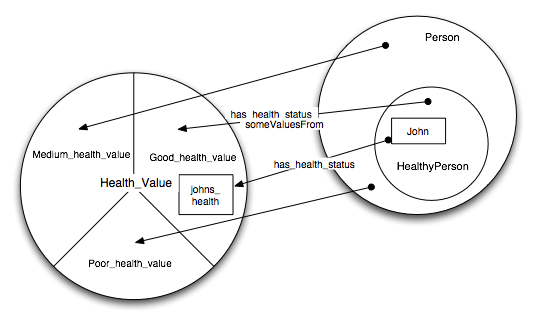
Figure 3: An adapted Venn diagram showing the use of
partitioning
classes to represent lists of values.
Representation for two variants of Pattern 2
There are two variants presented: one in which the individual Johns_health
is explicitly represented, the other in which it is implied by an
existential restriction.
Representation variant 1: Using a fact about the individual
{{Define the parent Value class to be
partitioned}}
:Health_Value
a owl:Class ;
owl:equivalentClass
[ a owl:Class ;
{{The next line makes the partition exhaustive}}
owl:unionOf (:Poor_health_value :Medium_health_value :Good_health_value
] .
{{Define each of the subclasses that make up the partitioon and make them pairwise disjoint}}
:Good_health_value
a owl:Class ;
rdfs:subClassOf :Health_Value ;
{{The disjoint axioms make the subclasses partitioning}}
owl:disjointWith :Poor_health_value , :Medium_health_value .
:Medium_health_value
a owl:Class ;
rdfs:subClassOf :Health_Value ;
owl:disjointWith :Poor_health_value , :Good_health_value
:Poor_health_value
a owl:Class ;
rdfs:subClassOf :Health_Value ;
owl:disjointWith :Good_health_value , :Medium_health_value .
{{Define the functional property
has_health_status with domain Person and range Health_value}}
:has_health_status
{{The property must be functional}}
a owl:ObjectProperty , owl:FunctionalProperty ;
rdfs:domain :Person ; {{Domain is optional and might be broader}}
rdfs:range :Health_Value {{Range is constrained to be Health_value and is mandatory for the pattern}}
{{Define The class Person, its
subclass
Healthy_person}}
:Person
a owl:Class.
{{Define Healthy_person}}
{{A Healthy_person is anything that is both a Person and whose health status is in the }}
{{Good_health_value subclass of Health_value}}
:Healthy_person
a owl:Class ;
owl:equivalentClass
[ a owl:Class ;
owl:intersectionOf (:Person [ a owl:Restriction ;
owl:onProperty :has_health_status ;
owl:someValuesFrom :Good_health_value
])
] .
{{Define John as an individual of type person and state that he has a health status Johns_health}}
:John
a :Person ;
:has_health_status :Johns_health .
{{Define the individual Johns_health as a Good_health_value}}
:johns_health
a :Good_health_value .
Representation using variant 2: Placing an existential restriction
on the
individual
It is not actually necessary to create the individual, Johns_health
explicitly. Instead, it is possible to use an
existential restriction to imply its existence but leave it
anonymous. In Figure 3 below this is shown by preceding the
name with an underscore and showing the box in dotted lines.
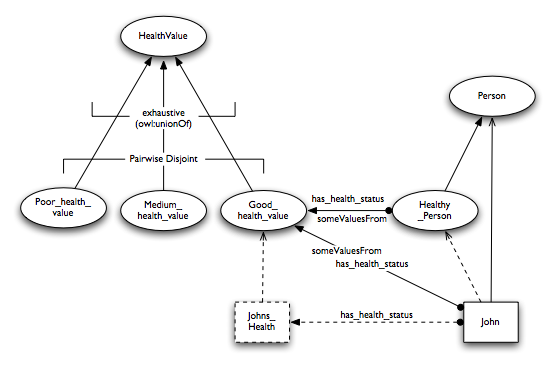
Figure 4: Pattern 2 variant 2 with an anonymous individual for John's
Health
To understand how this is done formally, remember that
restrictions in OWL are formally just another type of class, so to add
a restriction to an individual, you make the individual a type of the
restriction. So John is not only of of type Person,
but also of type restriction(has_health_status someValuesFrom
(GoodHealthStatus )). Or in N3 syntax:
{{Define John as an individual of type person and of type has_health_status someValuesFrom Good_health_status}}
:John a :Person ;
[a owl:Restriction;
owl:onProperty :has_health_status ;
owl:someValuesFrom :Good_health_value].
Considerations using Pattern 2:
- The result is in OWL-DL and classifies correctly using either
FaCT or Racer - and almost certainly any other reasoner that handles
any reasonable subset of OWL-DL.The semantics faithfully represent the
partitioning of a continuous feature space into a collection of
discrete value.
- The values can be further subpartitioned, e.g.
Good_health_value
might be split into Moderately_good_health_value and Robust_good_health_value,
simply by subdividing the Good_health_value partition.
- There can be several alternative partitionings of the same
feature space.
- If variant 2 is to be used as part of a database schema or
similar, then a convention for creating anonymous instances in the
database is required. (Logicians call such anonymous instances "skolem
constants".) In practice, this can usually be ignored. A common
convention is to use the class name or a string derived from it, e.g. "
good_health"
as the symbol in the database. The fact that, strictly speaking, the
semantics require the symbol to be interpreted in each case as a
different anonymous instance of the class Good_health_value
will be irrelevant to most applications and invisible to
most users. A problem only arises if the database is to be
re-interpreted in OWL, in which case either variant 1 or variant 2 must
be chosen and the necessary anonymous variables or restrictions
constructed for each occurrence of the value in the database.
- The use of classes for values seems unintuitive to many people
who come from the database and frame communities where value sets are
usually enumerated lists of symbols.
Code for this example
[N3]
[RDF/XML
abbrev] [Abstract
syntax]
Additional Considerations
- We would advise against mixing Pattern 1 and Pattern 2 in the
same ontology because it becomes difficult for authors to remember when
to use one and when the other. Maintaining a consistent
style is almost always to be preferred.
- In this note we have maintained the naming conventions that
classes begin with upper case letters and included the suffix "_value"
on the subclasses that make up value partitions.
- Creating a group of pairwise disjoint classes requires
combinatorially many disjoint axioms, i.e. it requires one axiom for
every pair of pairwise disjoint classes. (This does not happen
with individuals because the OWL standard provides an
allDifferent
axiom. Unfortunately it does not provide an analogous alllDisjoint
axiom.) Tools that implement OWL literally will encounter this
problem and OWL files implemented literally may grow very large very
quickly. There is a known work around that will be covered in a
supplementary note and is being implemented in some tools.
Acknowledgements
The code in these examples should be viewable with any owl tools.
The
following is for information only and with thanks to those involved in
developing the tools. There is no endorsement intended or implied for
the
specific tools. These examples have been produced using the Protege OWl
plugin and CO-ODE additional wizards and OwlViz available from http://protege.stanford.edu and
following plugins/backends/owl. Some files may require the CO-ODE
plugins
linked to that page or at http://www.co-ode.org.
Classification
involving individuals cannot all be shown in this form and has been
tested
using OilEd available from http://oiled.man.ac.uk.
In all cases the
Racer classifier has been used, available from http://www.sts.tu-harburg.de/~r.f.moeller/racer/.
Special thanks to Matthew Horridge for help with the final
drawings, to Pat Hayes for help with draft diagrams, and to Mike
Uschold for detailed reviews.
References
Rector, A., Modularisation of Domain Ontologies Implemented in
Description
Logics and related formalisms including OWL. in Knowledge Capture 2003,
(Sanibel Island, FL, 2003), ACM, 121-128. pdf
here
Welty, C. and Guarino, N. Supporting ontological analysis of
taxonomic relationships. Data and Knowledge Engineering, 39 (1).
51-74. pdf
here
Appendix: Diagramming conventions
- Ellipses represent classes, e.g.

- Squares represent instances., e.g. John

- Arrows:
- Closed
undecorated arrows (pointing upwards if possible) represent
rdfs:subclassOf;

-
- Open undecorated arrows indicate
rdf:type;

-
- arrows decorated with a blob on the origin
indicate
restrictions if between classes or facts if between individuals.

- Dotted arrows indicate that
the information represented is inferrable by a reasoner and not present
explicitly in the code given.
- Upward
facing square union symbols if spanning a set of
rdfs:subclassOf
arrowsor rdf:type arrowsindicate that the subclasses or individuals
exhaust the class - i.e. that they cover all possibilities. This
is expressed in OWL using owl:unionOf for classes or owl:oneOf for individuals
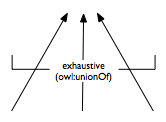
- Downwards facing braces
are used to indicate pairwise disjointness between subclasses or
owl:allDifferent for individuals. (All sibling
classes are disjoint and all individuals of each type are different in
these examples.)
